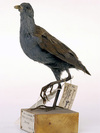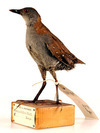Genus Porzana
Ash-throated Crake - Small secretive crake with a short bill. With black and olive brown streaks on the back. Tail is black, underparts slate, except throat is pale grey. Lower flanks and under tail coverts barred black and white. Sexes are alike. The nest is a large open bowl made out of dry grass, on the ground or just above. Well hidden between tree roots or grass. Clutch size is 2-5 eggs. No further data available. Diet consists of insects and insect larvae and grass seeds. Only appears in the open to feed.
Porzana astrictocarpus - After American ornithologist Alexander Wetmore described bones of the large Saint Helena Swamphen from Prosperous Bay, Saint Helena, in 1963, American paleontogologist Storrs Olson found almost complete skeletons of the Saint Helena Crake in the same region in 1973. These skeletons consists of bones which were smaller than the bones of Atlantisia podarces. Due to the peculiar shape of the carpometacarpus Olson named this species Porzana astrictocarpus.
Henderson Island Crake - Its natural habitat is subtropical or tropical moist lowland forests. It is threatened by habitat loss.
White-browed rail - The White-browed Crake is a species of bird in the Rallidae family. It is found in Australia, Brunei, Cambodia, Fiji, Hong Kong, Indonesia, Japan, Malaysia, Micronesia, New Caledonia, Palau, Papua New Guinea, the Philippines, Samoa, Singapore, Solomon Islands, Thailand, and Vanuatu.
Yellow-breasted crake - It is found in Argentina, Belize, Bolivia, Brazil, Cayman Islands, Colombia, Costa Rica, Cuba, the Dominican Republic, El Salvador, French Guiana, Guatemala, Guyana, Haiti, Jamaica, Mexico, Nicaragua, Panama, Paraguay, Puerto Rico, Suriname, Trinidad and Tobago, Uruguay, Venezuela, the US.
Ruddy-breasted Crake - Its breeding habitat is swamps and similar wet areas across south Asia from the Indian subcontinent east to south China, Japan and Indonesia. It has been recorded as a vagrant from the Australian territory of Christmas Island. This crake nests in a dry location on the ground in marsh vegetation, laying 6-9 eggs. It is mainly a permanent resident throughout its range, but some northern populations migrate further south in winter.
Kosrae Crake - It was discovered in 1827 by Heinrich von Kittlitz. Von Kittlitz described its plumage as general black with bluish gloss. The quills were more brownish. The chin and the middle of the troat were brown. The surface of its tail were brownish-black. The undertail coverts exhibit white spots. The inner wing coverts were brownish and were spotted with white. The outer edged of the first primary was dull brown. Eyes, legs and feet had a reddish hue. The bill was black. Its size was about 18 cm.
Porzana nigra - The Miller's Rail was a species of bird in the Rallidae family. It was endemic to Tahiti. It was discovered and painted by Georg Forster during the second Cook voyage.
Laysan Crake - The Laysan Rail or Laysan Crake was a tiny inhabitant of the Northwest Hawaiian Island of Laysan. This small island was and still is an important seabird colony, and sustained a number of endemic species, including the rail. It became extinct due to habitat loss by domestic rabbits, and ultimately World War II. Its scientific name honours Henry Palmer, who collected in the Hawaiian Islands for Walter Rothschild.
Little Crake - Their breeding habitat is reed beds in Europe, mainly in the east, and just into western Asia. They nest in a dry location in reed vegetation, laying 4-7 eggs. This species is migratory, wintering in Africa.
Spotted crake - Their breeding habitat is marshes and sedge beds across temperate Europe into western Asia. They nest in a dry location in marsh vegetation, laying 6-15 eggs. This species is migratory, wintering in Africa and Pakistan.
Baillon's Crake - Their breeding habitat is sedge beds in Europe, mainly in the east, and across Asia. They used to breed in Great Britain up to the mid-19th century, but the western European population declined through drainage. They nest in a dry location in wet sedge bogs, laying 4-8 eggs. This species is migratory, wintering in east Africa and south Asia.
Hawaiian Crake - The Hawaiian Rail , Hawaiian Spotted Rail, or Hawaiian Crake was a somewhat enigmatic species of diminutive rail that lived on Big Island of Hawaiʻi, but is now extinct. It was a flightless bird that was apparently found in shrubland and secondary growth on abandoned fields and in times of danger had the habit of hiding in Polynesian Rat burrows. Specimens are known or assumed to be from an area which roughly corresponds to the middle elevations of today's Puna district around the present settlement of Mountain View, below the primary rainforest. A dark form and a lighter, spotted one are known .








